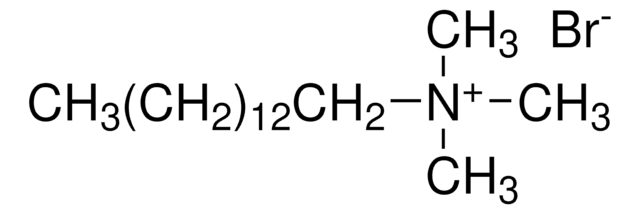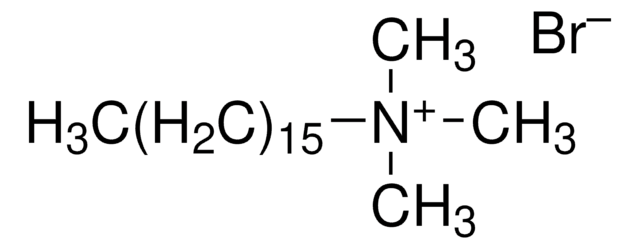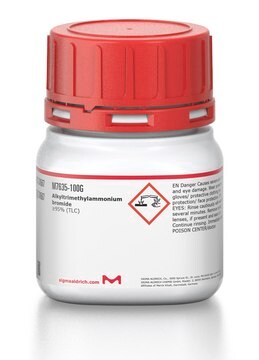87208
Myristyltrimethylammonium bromide
suitable for ion pair chromatography, LiChropur™, ≥99.0% (AT)
Synonym(s):
Tetradecyltrimethylammonium bromide, Trimethyl(tetradecyl)ammonium bromide
About This Item
Recommended Products
description
cationic
Quality Level
Assay
≥99.0% (AT)
form
crystals
quality
LiChropur™
mol wt
micellar avg mol wt 27,000
aggregation number
80
technique(s)
ion pair chromatography: suitable
CMC
4-5 mM (20-25°C)
mp
245-250 °C (lit.)
λ
10 % in H2O
UV absorption
λ: 240 nm Amax: ≤0.08
λ: 250 nm Amax: ≤0.05
λ: 260 nm Amax: ≤0.04
λ: 500 nm Amax: ≤0.02
suitability
corresponds to standard for filter test
SMILES string
[Br-].CCCCCCCCCCCCCC[N+](C)(C)C
InChI
1S/C17H38N.BrH/c1-5-6-7-8-9-10-11-12-13-14-15-16-17-18(2,3)4;/h5-17H2,1-4H3;1H/q+1;/p-1
InChI key
CXRFDZFCGOPDTD-UHFFFAOYSA-M
Looking for similar products? Visit Product Comparison Guide
General description
Legal Information
Signal Word
Danger
Hazard Statements
Precautionary Statements
Hazard Classifications
Acute Tox. 4 Oral - Aquatic Acute 1 - Aquatic Chronic 1 - Eye Dam. 1 - Skin Irrit. 2 - STOT RE 2 Oral - STOT SE 3
Target Organs
Gastrointestinal tract, Respiratory system
Storage Class Code
11 - Combustible Solids
WGK
WGK 3
Flash Point(F)
Not applicable
Flash Point(C)
Not applicable
Personal Protective Equipment
Choose from one of the most recent versions:
Already Own This Product?
Find documentation for the products that you have recently purchased in the Document Library.
Customers Also Viewed
Our team of scientists has experience in all areas of research including Life Science, Material Science, Chemical Synthesis, Chromatography, Analytical and many others.
Contact Technical Service











